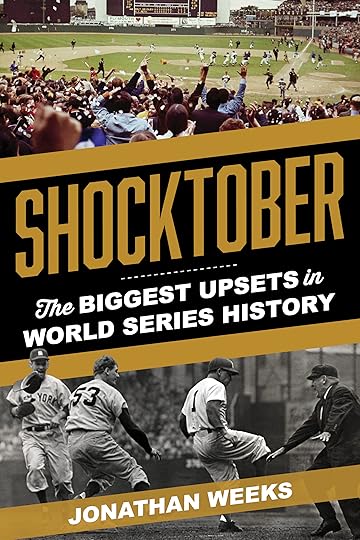Shocktober: The Biggest Upsets in World Series History

Shocktober: The Biggest Upsets in World Series History
Jonathan Weeks
~~~~~~~~~~~~~
GENRE: Sports History
~~~~~~~~~~~~~
BLURB:
Mays’s spectacular catch in 1954, Bill Mazeroski’s walk-off homer in 1960, and Kirk Gibson’s pinch-hit blast in 1988 are just a few of the memorable moments that have dominated highlight reels. The outcome of the Series has not always been terribly surprising—especially during the late 1940s and early 1950s when the Yankees captured five consecutive championships, breaking their previous record of four straight titles from 1936 to 1939. But despite its predictability at times, the Fall Classic has taken many unexpected turns. The 1906 Cubs lost to the weak-hitting White Sox after establishing a new regular season record for
wins. The 1955 Dodgers avenged seven prior October failures with an improbable victory over the seemingly invincible Yankees. And in 1969, the Mets finally shed their image as “loveable losers,” dethroning the powerful Orioles. In more than a century of World Series plays, a number of similar scenarios have emerged; twenty-two of those stories are told in Shocktober.

~~~~~~~~~~~~~
EXCERPT
To understand why members of the White Sox conspired with gamblers to throw the 1919 World Series, one must take into account the financial climate of baseball in the early-20th century. Players weren’t paid exceptionally well (at least in comparison to today). Before the advent of free agency, owners held most of the advantages when it came to negotiating contracts. Players were more or less stuck with the clubs they had signed with until team executives decided it was time to get rid of them. Typical deadball stars were minimally educated and rough around the edges. In their free time, many gravitated to bars and pool halls, where men of questionable integrity could be found. Some players developed relationships with members of the underworld—especially bookmakers who were willing to tamper with the outcome of games in order to turn a profit.
Ty Cobb, one of the biggest names of the era, was paid $20,000 in 1919—equivalent to about $348,000 today. No one else was making that much at the time—not even Babe Ruth. Pitcher Eddie Cicotte, at a little over $9,000, was the highest paid member of the Chicago conspirators. The others were earning significantly less.
A common misconception among contemporary fans is the idea that Chicago team owner Charles Comiskey was a nefarious miser who drove his men to commit the crime of the century. Multiple myths have persisted regarding Comiskey’s penny-pinching ways—the most salacious being the story about how he delivered a case of flat champagne to his players as a World Series bonus in 1917. Other fallacies have been handed down over the years.
In reality, Comiskey was prone to acts of generosity. He allowed a number of Chicago organizations to use his ballpark for free and gave out complimentary grandstand tickets to school children. During World War I, he donated a significant portion of his annual income to the Red Cross. While it’s true that he could also be frugal, charging players for laundry fees, he actually paid his men pretty well. The White Sox Opening Day payroll in 1919 was among the highest in baseball.
While the specific motivations of each conspirator have been endlessly debated, it’s safe to assume that the primary incentive was financial gain. By his own account, it was first baseman Chick Gandil who approached gamblers with the idea of a fix. At the time, the club was divided into two social cliques with tension existing between the two. The educated players fell under the influence of Ivy League graduate Eddie Collins. The rest of the joiners cast their lot with Gandil—a former boxer with an attitude toward authority. Shortstop Swede Risberg played a major role in the fix as well, helping Gandil lure other players (ones who could be trusted to keep their mouths shut) into the fold. Boston-based bookmaker Joseph “Sport” Sullivan convinced New York underworld kingpin Arnold Rothstein to bankroll the plot. Others involved included “Sleepy Bill” Burns (a former pitcher) and Abe Attell (a former featherweight boxing champion). Both were associates of Rothstein’s.
~~~~~~~~~~~~~
AUTHOR Bio and Links:
Jonathan Weeks has written several sports biographies and two novels, one of which was a posthumous collaboration with his late father. He grew up in the Capital District region of New York State and currently works in the mental health field.
BLOG: http://www.jonathanweeks.blogspot.com
GOODREADS AUTHOR PAGE: https://www.goodreads.com/author/list/5862273.Jonathan_Weeks
~~~~~~~~~~~~~
RAFFLECOPTER GIVEAWAY
Jonathan Weeks will be awarding a $25 Amazon/BN gift card to a randomly drawn winner.
Enter to win a $25 Amazon/BN gift card – a Rafflecopter giveaway
~~~~~~~~~~~~~
Q & A With Jonathan Weeks
Tell us about you as a person.
I grew up in the Capital District Region of New York State during a time when most young boys were encouraged to get involved with sports. I played organized baseball and basketball, but it became abundantly clear early on that I would never make a career out of either activity. Although I was never able to hit a curveball or reliably catch a high pop-up, I always found myself drawn to the sport of baseball. A career as a sports writer seemed as far out of reach as my major league aspirations, so I studied psychology in college and made my living in the mental health field. I experimented with various forms of writing on the side—novels, short stories, screenplays. After decades of failure, I finally found my niche as a baseball writer. I have been able to publish two novels in addition to multiple non-fiction sports books.
If you could hang out with one famous person for one day, who would it be and why?
Oh man—this is a tough question. There are so many people I admire in so many different ways. If I could hang with one writer for a day, I would tag along with Stephen King because I would love to find out what his process is. If I could spend time with an athlete, it would be Derek Jeter—simply because he’s my favorite Yankee player of all-time and seems like a fundamentally decent guy.
What’s the story behind your latest book?
I’ve been doing a lot of written interviews for my latest release and it all seems to come down to the same point in time. When I was a kid, my Mom always encouraged us to read. She would take me and my three sisters to the public library. There were two books I used to borrow regularly. One was a children’s picture book called The Man Who Lost His Head. Originally published in 1942, it tells the story of a man who wakes up without his head and tries to find a suitable replacement, using a pumpkin, a parsnip, and a block of wood until he ends up reunited with the original appendage. The other one was a book about the World Series. The name of this particular World Series book escapes me, but it was filled with old black and white photos from Fall Classics of yesteryear. I found it so fascinating that I vowed to write my own book on the topic someday. Now—more than 50 years later, I can say that I actually have.
What advice do you have for other writers who want to get the word out about their latest book?
I would say hiring a publicist is the way to go.
List 5 things on your bucket list.
—Attend a World Series game at Yankee Stadium.
—Live long enough to have grandkids and watch them grow up.
—Write another novel.
—Learn how to play Van Halen’s “Eruption” note for note.
—Tour the ancient ruins in Rome, Egypt, and South America.
Any final thoughts?
We should all be kind to each other. Kindness is a dying art nowadays it seems.



